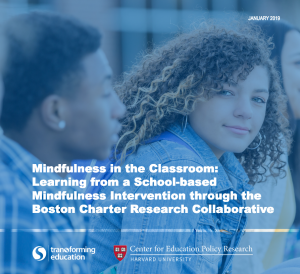 A new study suggests that mindfulness education — lessons on techniques to calm the mind and body — can reduce the negative effects of stress and increase students’ ability to stay engaged, helping them stay on track academically and avoid behavior problems.
A new study suggests that mindfulness education — lessons on techniques to calm the mind and body — can reduce the negative effects of stress and increase students’ ability to stay engaged, helping them stay on track academically and avoid behavior problems.
While small, the study of sixth-graders at a Boston charter school adds to a still-growing body of research about a role for mindfulness in the classroom. In recent years, the topic has excited researchers and educators alike as a possible tool to help students face both behavioral and academic challenges by reducing anxiety and giving them a new way to handle their feelings and emotions.
After finding that students who self-reported mindful habits performed better on tests and had higher grades, researchers with the Boston Charter Research Collaborative — a partnership between the Center for Education Policy Research at Harvard University (CEPR), MIT, and Transforming Education — wanted to know if school-based mindfulness training could help more students reap similar benefits.
They designed a study focusing on sixth-graders in another Boston-area school. The study, published in a white paper by a team including Martin West of the Harvard Graduate School of Education, showed that sixth-graders who participated in an eight-week mindfulness were less stressed out than their classmates who hadn’t.
The paper includes recommendations from educators and leaders of mindfulness-based education programs for implementing mindfulness in your own school:
Would you like to learn more about this study? Download a PDF of the white paper: Mindfulness in the Classroom: Learning from a School-based Mindfulness Intervention through the Boston Charter Research Collaborative.
Excerpted from “Making Time for Mindfulness” in Usable Knowledge, a research newsletter for educators produced by the Harvard Graduate School of Education. Read the full article.